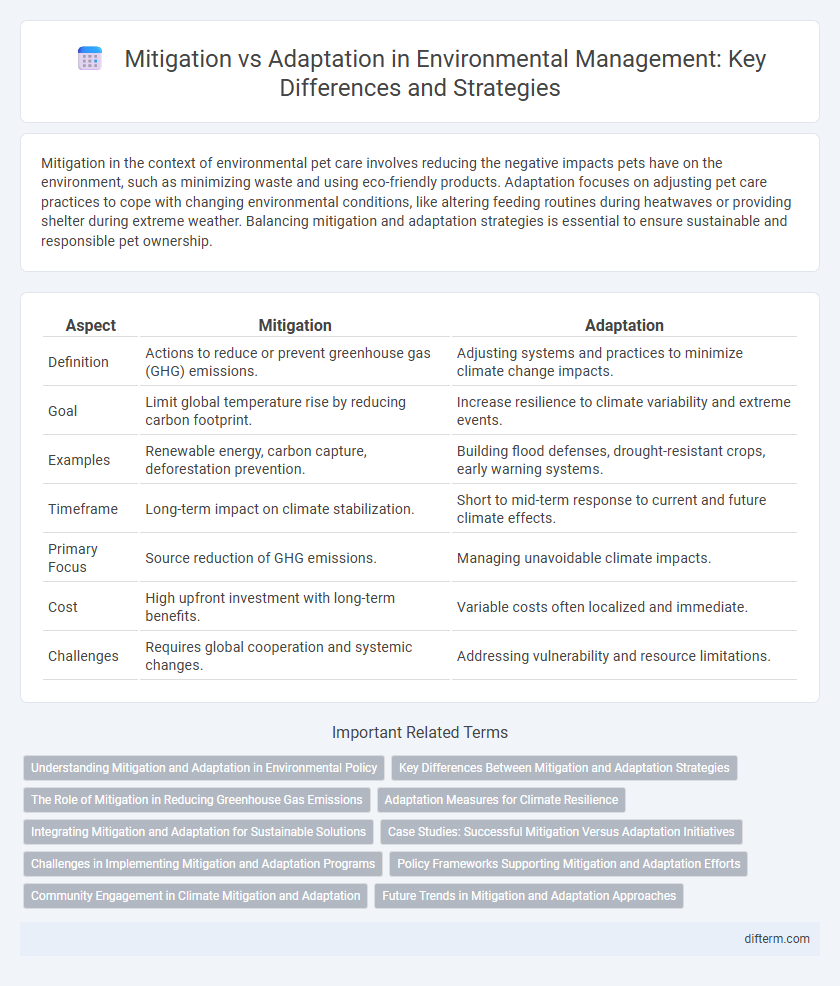Mitigation in the context of environmental pet care involves reducing the negative impacts pets have on the environment, such as minimizing waste and using eco-friendly products. Adaptation focuses on adjusting pet care practices to cope with changing environmental conditions, like altering feeding routines during heatwaves or providing shelter during extreme weather. Balancing mitigation and adaptation strategies is essential to ensure sustainable and responsible pet ownership.
Table of Comparison
| Aspect | Mitigation | Adaptation |
|---|---|---|
| Definition | Actions to reduce or prevent greenhouse gas (GHG) emissions. | Adjusting systems and practices to minimize climate change impacts. |
| Goal | Limit global temperature rise by reducing carbon footprint. | Increase resilience to climate variability and extreme events. |
| Examples | Renewable energy, carbon capture, deforestation prevention. | Building flood defenses, drought-resistant crops, early warning systems. |
| Timeframe | Long-term impact on climate stabilization. | Short to mid-term response to current and future climate effects. |
| Primary Focus | Source reduction of GHG emissions. | Managing unavoidable climate impacts. |
| Cost | High upfront investment with long-term benefits. | Variable costs often localized and immediate. |
| Challenges | Requires global cooperation and systemic changes. | Addressing vulnerability and resource limitations. |
Understanding Mitigation and Adaptation in Environmental Policy
Mitigation in environmental policy focuses on reducing greenhouse gas emissions to limit global warming and its impacts, primarily through renewable energy adoption and carbon footprint reduction strategies. Adaptation involves adjusting ecosystems and human systems to minimize harm from climate change effects, such as rising sea levels and extreme weather events. Effective environmental policy integrates both approaches to enhance resilience and sustainability in the face of climate challenges.
Key Differences Between Mitigation and Adaptation Strategies
Mitigation strategies focus on reducing greenhouse gas emissions and enhancing carbon sinks to limit global warming, while adaptation strategies prioritize adjusting natural or human systems to minimize climate change impacts. Key differences include mitigation's goal to address the root causes of climate change versus adaptation's emphasis on resilience and vulnerability reduction in communities and ecosystems. Effective climate policy integrates both approaches to achieve sustainable environmental outcomes and long-term climate stability.
The Role of Mitigation in Reducing Greenhouse Gas Emissions
Mitigation plays a critical role in reducing greenhouse gas emissions by implementing strategies such as transitioning to renewable energy sources, enhancing energy efficiency, and promoting carbon capture technologies. Effective mitigation efforts target the root causes of climate change, directly addressing emissions from industrial processes, transportation, and deforestation. Prioritizing mitigation not only limits global temperature rise but also supports sustainable development and protects ecosystems from long-term climate impacts.
Adaptation Measures for Climate Resilience
Adaptation measures for climate resilience involve implementing strategies such as sustainable water management, infrastructure reinforcement, and ecosystem restoration to reduce vulnerability to climate change impacts. These measures enhance the ability of communities and natural systems to cope with extreme weather, sea-level rise, and shifting agricultural conditions. Prioritizing adaptive practices supports long-term socio-economic stability and biodiversity preservation in the face of ongoing environmental challenges.
Integrating Mitigation and Adaptation for Sustainable Solutions
Integrating mitigation and adaptation strategies enhances resilience against climate change while reducing greenhouse gas emissions, creating more sustainable environmental outcomes. This approach maximizes resource efficiency by aligning adaptation actions with mitigation goals, such as promoting renewable energy alongside ecosystem restoration. Emphasizing co-benefits supports long-term sustainability and ensures comprehensive climate action.
Case Studies: Successful Mitigation Versus Adaptation Initiatives
Case studies reveal that mitigation initiatives, such as Costa Rica's reforestation program, significantly reduced carbon emissions while enhancing biodiversity. In contrast, Bangladesh's flood-resistant infrastructure exemplifies successful adaptation by minimizing climate impact on vulnerable communities. These examples highlight tailored responses that address either emission reduction or resilience building in climate policy.
Challenges in Implementing Mitigation and Adaptation Programs
Challenges in implementing mitigation and adaptation programs include limited financial resources, insufficient technological capacity, and lack of community engagement. Complex governance structures often hinder coordinated efforts, while varying regional vulnerabilities demand tailored approaches that are difficult to standardize. Data gaps and uncertainty in climate projections further complicate effective decision-making and long-term planning.
Policy Frameworks Supporting Mitigation and Adaptation Efforts
Policy frameworks supporting mitigation and adaptation efforts integrate regulatory measures, funding mechanisms, and stakeholder collaboration to enhance resilience against climate change impacts. Nationally Determined Contributions (NDCs) under the Paris Agreement emphasize emission reduction targets while promoting adaptive capacity in vulnerable sectors such as agriculture and infrastructure. Effective policies leverage cross-sectoral approaches, incentivize clean technologies, and ensure equitable resource distribution to balance mitigation goals with adaptation needs.
Community Engagement in Climate Mitigation and Adaptation
Community engagement plays a crucial role in climate mitigation and adaptation by fostering local participation in designing and implementing sustainable strategies. Empowering communities with knowledge and resources enhances resilience to climate impacts and encourages behavioral changes that reduce greenhouse gas emissions. Collaborative efforts between governments, NGOs, and residents optimize the effectiveness of climate action plans tailored to specific environmental and social contexts.
Future Trends in Mitigation and Adaptation Approaches
Future trends in mitigation focus on scalable renewable energy technologies, carbon capture innovations, and nature-based solutions to reduce greenhouse gas emissions effectively. Adaptation approaches increasingly integrate climate-resilient infrastructure, community-based risk management, and real-time data analytics to enhance preparedness and response. Synergizing mitigation and adaptation strategies accelerates sustainable development and strengthens global climate resilience.
mitigation vs adaptation Infographic

 difterm.com
difterm.com